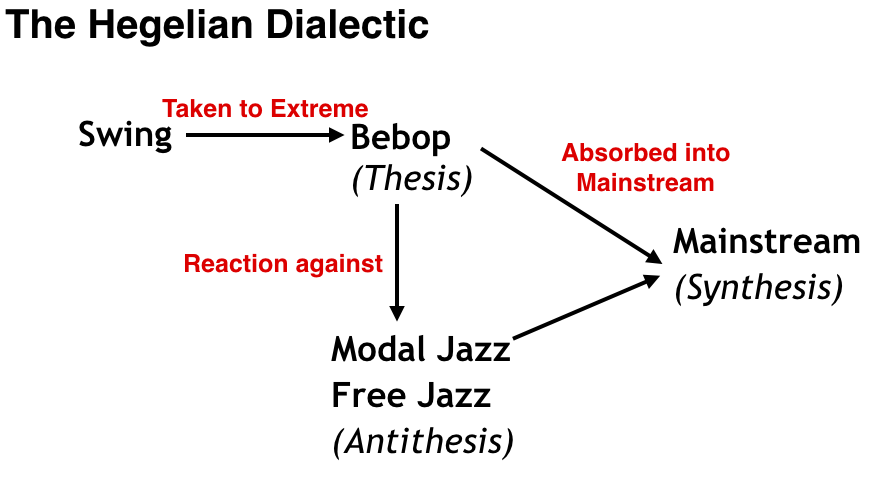You Have Nothing to Lose but Your Chains
Modern Jazz can be described as ‘The Decline & Fall of the Chord‘ or ‘The War on Chords‘ – with the ultimate goal of freer improvisation.
In the early 20th century, Jazz was tonal. Dixieland Jazz, Bebop, Hard-bop, Cool Jazz – these are all different styles of Jazz, each with their own characteristics and complexities, but they are all tonal. Tonal Jazz relies heavily on chord progressions. Solos are derived almost entirely from the underlying chords (by playing Guide Tones and avoiding Avoid Notes). This (thinking in terms of chords and progressions) is called ‘Vertical Thinking‘.
But then Miles Davis came along, with his Kind of Blue album. This introduced (along with the album Milestones before it) modality to Jazz. It moved away from the ‘dense’ and ‘thick’ chord heavy compositions of Bebop and moved towards a less busy style of Jazz, with fewer chords and a slower harmonic rhythm. This meant soloist couldn’t rely solely on the chords to get him (or her) through an improvisation, instead he had to create interesting melodies himself. The soloist was free to explore a particular scale or mode without regard for guide tones or avoid notes or any nonsense like that. This (thinking in terms of scales and melodies) is called ‘Horizontal Thinking‘. Miles himself called Modal Jazz “a return to melody”. Thus improvisation slightly loosened the chains that bound it to the chord.
Free Jazz took this trend further by discarding chords completely (at least in Ornette Coleman’s version of Free Jazz). Thus there was literally no harmony at all to adhere to. The soloist was completely free to play anything he (or she) wanted. Thus improvisation finally broke free of the chains that once tied it to the chord.
Improvisation Unbound
Below is a brief summary of the key characteristics of Tonal, Modal and Free Jazz.
| Device | Tonal Jazz | Modal Jazz | Free Jazz |
|---|---|---|---|
| Chords | Functional | Non-Functional | No Chords |
| Voicings | Tertian (3rds) | Quartal (4ths) | No Chords |
| Chord Mvt | Circle of Fifths | Stepwise | None |
| Melody | Guide Tones | Character Tones | Chromatic |
| Improv | Solo Improv | Solo Improv | Collective Improv |
| Goal of Improv | Restate Chords | Explore scale | Emotive Melody |
| Thinking | Vertical (chords) | Horizontal (scales) | Horizontal |
| Meter | 4/4 | 4/4 | None |
| Form | Short Form | Short Form | Extended Form |
Vertical vs Horizontal
Modern Jazz can also be described is the gradual moving away from vertical thinking, towards horizontal thinking. These terms were alluded to above, but it’s worth restating them here.
- Vertical Thinking = in terms of chords
- Horizontal Thinking = in terms of scales
Note: Both ‘ways of thinking’ can use chromatic notes and a vertical solo can sound exactly the same as a horizontal – this is purely a way of thinking about improvisation.
Modern Jazz – The Only Rule is that There are No Rules
In Modern Jazz – all things are relative. There are no rules. There are no right or wrongs. You can do whatever you like, as long as you want to do it (i.e. this is not Aleatoric Music – it’s NOT pure randomness and chance). If there is a Tonal Centre, then it functions as a reference point for your relativity.
And while it can be fun & challenging to play a whole song in modal or atonal harmony, Contemporary Jazz doesn’t restrict itself to only one type of ‘harmony’. You can and should use a combination of tonality, modality, and atonality all in the same song – this makes for a much more interesting performance. This is how music (and everything else in society) evolves. First whatever currently exists (Swing) is taken to the extreme (Bebop), then there is a reaction against it (Modal and Free Jazz), then both are incorporated into the mainstream (Contemporary Jazz). This is called the Hegelian Dialectic. Once the novelty of ‘the new thing‘ has worn off, it is just absorbed into the mainstream and used as one of the many colours on a musicians palette.
- Hegelian Dialectic: a thesis elicits a reaction and gives rise to its own antithesis, until both are absorbed by a synthesis.

So a Contemporary Jazz song may use tonality, modality & atonality all in a single song:
- Tonal → Modal → Tonal → Atonal → Silence → Tonal
Have a Listen to
- For songs that jump between Tonal & Modal check out:
- Juju ~ Wayne Shorter
- House of Jade ~ Wayne Shorter
- Dolphin Dance ~ Herbie Hancock
- For songs that jump between Tonal & Atonal check out:
- Early Cecil Taylor (‘Looking Ahead!’ album)
- Early Ornette Coleman (‘The Shape of Jazz to Come’ album)
- For songs that jump between Modal & Atonal check out:
- Most of Coltrane’s albums in the 1960’s. Check out ‘Impressions’, ‘A Love Supreme’, ‘Meditations’ and ‘Live in Seattle’